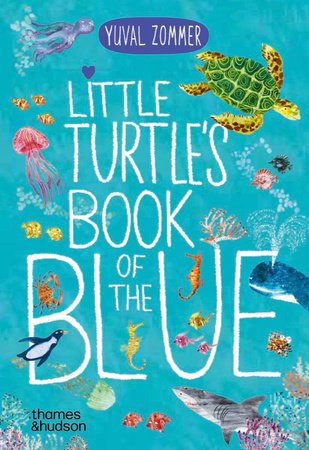The Verbs that Drive Turtles and Snails in Yuval Zommer’s Board Books
On the day after Earth Day, you will forgive me for turning away from looming calamities of plastic and fires and floods and for writing instead about a book in which a baby turtle swims out to sea and encounters marine life from playful to scary. This is Little Turtle’s Book of the Blue by Yuval Zommer. Verbs in the text invite the youngest listeners to drift along through the lively, light-drenched illustrations, from sunshine to nighttime. Little turtle swims…plays… scuttles… swishes…watches…and more on this undersea adventure! Ten kinds of marine life, and in addition to the verbs in the text pointing to each one, more verbs well out of every ocean scene, from turtle’s own launching with “PADDLE! PADDLE!” to the “FLIP! FLAP!” of flying fish and the “WHOOSH!” of a passing whale. The final page breaks the pattern.
Snails being slower than turtles, the companion book, Little Snail’s Book of Bugs, features slower, more considered and often more interior verbs like “wants,” “sees,” “hears,” and my personal favorite, “hides.” The same delicacy marks the illustrations—the feathery legs of centipedes and the quick jumpiness of crickets. Once again, additional verbs leap off the page, inviting toddlers to sound them out. “CHIRP! CHIRP!” “SPIN! SPIN!” “CRUNCH! CRUNCH!” Here too, the final spread provides a lovely surprise, serving to affirm the structure it departs from.
If, like me, you marvel at the hard-to-crack code of board books, if you wonder what makes them so notoriously difficult to write, then breaking down this text and seeing how it operates feels like a good place to start.

